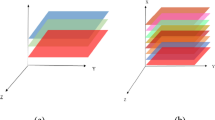A variety of pictures in hyperspectral fields requires a reduction in dimensionality, which often needs unique algorithms such as principal component analysis and minimum noise fraction (MNF). This article investigates the improved method of non-negative sparse matrix transformation based on the maximum likelihood covariance estimation and the Frobenius norm to better achieve dimensionality reduction. Non-negativity is presented based on the sparse matrix, which reduces the calculation time and improves efficiency. In order to verify the non-negative sparse matrix transforms (n-SMT) algorithm, samples eroded by disease were selected in the experiment and classified to identify the different parts of leaves after dimension reduction. Besides the n-SMT method, the MNF algorithm is also applied to all the samples. This article compares the two algorithms’ operating time and verifies the accuracy of classification after the n-SMT algorithm.
Similar content being viewed by others
References
X. Jia, B. C. Kuo, and M. M. Crawford, Proc. IEEE, 101, No. 3, 676–697 (2013).
D. Landgrebe, IEEE Signal Proc. Magazine, 19, No. 1, 17–28 (2002).
W. Jing and C. I. Chang, IEEE Trans. Geosci. Remote, 44, No. 6, 1586–1600 (2006).
M. Fauvel, Y. Tarabalka, J. A. Benediktsson, J. Chanussot, and J. Tilton, Proc. IEEE, 101, No. 3, 652–675 (2013).
C. A. Manogue and T. Dray, Mod. Phys. Lett. A, 14, No. 2, 99–103 (2013).
D. Zhang and Y. Le Y, Int. Conf. Comput. Intelligence & Industrial Application (2010).
L. R. Bachega and C. A. Bouman, Int. Conf. Image Proc. IEEE (2010).
A. L. Bertozzi and A. Flenner, Multiscale Model Sim., 10, No. 3, 1090–1118 (2012).
J. Theiler, G. Cao, et al., IEEE J. Sel. Top. Signal Process, 5, No. 3, 424–437 (2011).
G. Cao, L. Bachega, et al., IEEE Trans. Image Process, 20, No. 3, 625–640 (2011).
N. Kochan, G. Y. Tütüncü, and G. Giner, Expert Syst. Appl., 167, No. 3, Article ID 114200 (2020).
J. Fan and L. Yuan, An. Stat., 39, No. 6, 3320–3356 (2011).
D. D. Lee, H. S. Seung, et al., Nature, 401, 788–791 (1999).
P. O. Hoyer, J. Mach. Learn Res., 5, No. 9, 1457–1469 (2004).
A. Copar, M. Zitnik, and B. Zupan, Biodata Min., 10, No. 1, 41 (2017).
Y. L. Xie, P. K. Hopke, and P. Paatero, J. Chem., 12, No. 6, 357–364 (2015).
H. Zhi, X. Yu, G. Wang, and Z. Wang, Fifth Int. Conf. Fuzzy System and Knowledge Discovery, FSKD 2008, IEEE, Vol. 4, pp. 29–33, Jinan, Shandong, China (2008)
D. Bo, M. M. Lin, and M. T. Chu, Numer. Algorithms, 65, No. 2, 251–274 (2014).
Y. Chen, A. Wiesel, and A. O. I. Hero, IEEE Trans. Signal Process, 59, No. 9, 4097–4107 (2011).
M. Pal and G. Foody, IEEE Trans. Geosci. Remote, 48, No. 5, 2297–2307 (2010).
Z. Emre, E. Tülin, and M. E. Karslgil, 13th European Signal Processing Conf. IEEE (2015).
Y. Bazi and F. Melgani, IEEE Trans. Geosci. Remote, 44, No. 11, 3374–3385 (2003).
K. Hajian-Tilaki, Caspian J. Int. Med., 4, No. 2, 627–635 (2013).
S. D. Walter, State Med., 24, No. 13, 2025–2040 (2005).
Author information
Authors and Affiliations
Corresponding author
Additional information
Abstract of article is published in Zhurnal Prikladnoi Spektroskopii, Vol. 89, No. 3, p. 436, May–June, 2022.
Rights and permissions
Springer Nature or its licensor holds exclusive rights to this article under a publishing agreement with the author(s) or other rightsholder(s); author self-archiving of the accepted manuscript version of this article is solely governed by the terms of such publishing agreement and applicable law.
About this article
Cite this article
Deng, Z., Fu, Y., Zhao, S. et al. Application of Non-Negative Sparse Matrix Transformation in Hyperspectral Analysis. J Appl Spectrosc 89, 593–601 (2022). https://doi.org/10.1007/s10812-022-01399-1
Published:
Issue Date:
DOI: https://doi.org/10.1007/s10812-022-01399-1




